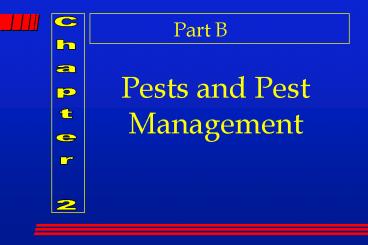Core Manual Template - PowerPoint PPT Presentation
1 / 78
Title:
Core Manual Template
Description:
Plant sucking pets. Cutworms. Underground feeders. Leaf ... Plant Sucking Pests. Cutworm. Underground Feeder. Goosenecking caused by underground feeders ... – PowerPoint PPT presentation
Number of Views:87
Avg rating:3.0/5.0
Title: Core Manual Template
1
Part B
Pests and Pest Management
Chapter 2
2
What is a pest?
3
When is Pest Control Necessary?
Economic Losses
Control Costs
4
Pest Management Strategies
- Prevention
- Suppression
- Eradication
5
Main Pest Categories
- Insect insectlike pests
- Plant diseases
- Weeds
- Vertebrates
6
Insect and Insectlike Pests
Beneficial Insects
7
Insect and Insectlike Pests
Destructive Insects
8
Insect Physical Characteristics
9
Insect Mouthparts
- Chewing
- Piercing/sucking
- Siphoning
- Sponging
10
Chewing
11
Piercing/Sucking
Mosquito
12
Siphoning
13
Sponging
14
Life Cycle of Insects
- Various development sequences
- Changes are called metamorphosis
- Influenced by temperature, light and humidity
15
Gradual Metamorphosis
16
Complete Metamorphosis
17
Insectlike Pests
- Mites
- Ticks
- Spiders
- Pillbugs
- Nematodes
- Mollusks
18
Arachnids
as
Mites Ticks Spiders
19
Nematodes
20
Plant Pests
- Leaf Feeders
- Internal feeders
- Stalk or stem borers
- Plant sucking pets
- Cutworms
- Underground feeders
21
Leaf Feeders
22
Internal Feeders
European Corn Borer
23
Stalk or Stem borers
Potato Tuberworm
24
Plant Sucking Pests
25
Cutworm
26
Underground Feeder
Goosenecking caused by underground feeders
27
Pests of Animals
Flea
28
Factors in Managing Insects
- Habitat
- Feeding Habits
- Identification of life stages
- Environmental conditions
29
Life Cycle Stages
- Egg
- Early larva/nymph
- Late instar
- Pupal
- Adult
30
Biological Controls
- Predators and parasites
- Pheromones
- Juvenile hormones
- Microbials
31
Predators Parasites
Parasitic Wasp
32
Pheromones
Pheromone Trap
33
Microbial Pesticides
Applying Bt to control gypsy moth
Gypsy moth larvae
34
Cultural Control of Insect Pests
- Crop rotation
- Trap crops
- Delayed planting
- Timely harvest
35
Crop Rotation
Wheat
Soybeans
Alfalfa
Corn
36
Trap Crops
Insect infected trap crop
Protected Potatoes
37
Planting/Harvesting
38
Chemical Control
- Repellents Keep pests away from specific host.
- Poisons Contact poisons kill when a pest
touches them. Stomach poisons kill the pest when
eaten.
39
Applying Insecticides
40
Plant Diseases
41
Plant Responses to Pathogenic Diseases
- Overdeveloped tissue (galls)
- Underdeveloped tissue (stunting)
- Tissue death (blight)
42
Fungi
Fungal infection on hawthorn
43
Bacteria
Crown Gall
44
Viruses, Viroids and Mycoplasmas
Barley yellow dwarf virus in wheat
45
Plant Diseases
- Symptoms
- Leaf spots, wilts, galls, stunted growth
- Signs
- Fungal spores, mycellum, bacterial ooze
46
Diagnosing Plant Diseases
47
Managing Plant Diseases
- Host resistance
- Cultural control
- Mechanical control
- Sanitation
- Chemical control
48
Host Resistance
Wheat on right infected with Barley Yellow Dwarf
Virus. Wheat on left resistant to virus.
49
Cultural Control
- Crop rotation
- Planting time
- Seed Storage
50
Mechanical Control
Heat may be used to pasteurize soil
51
Sanitation
Bin cleaning reduces disease risks
52
Chemical Control
53
Fungicide Classifications
- Protectants
- Eradicants
- Systemics
54
Timing and Coverage of Fungicide Applications
55
Weeds
56
Indirect Weed Damage
Weeds clog waterways
57
Life Cycle of Weeds
Annuals
Marestail
Velvetleaf
58
Life Cycle of Weeds
Biennials
Wild Carrot Yellow
Rocket
59
Life Cycle of Weeds
Perennial
Bind Weed Curly
Dock
60
Weed Classifications
- Land Plants
- Grasses
- Sedges
- Broadleaf
- Aquatic Plants
- Vascular
- Algae
61
Grass Weeds
Grasses may have fibrous roots and rhizomes
62
Sedges
Yellow Nutsedge
63
Broadleaf Weeds
Wild Mustard Wild Buckwheat
64
Aquatic Plants
- Vascular Plants
- Cattails
- Water Lilies
- Algae
- Planktonic
- Filamentous
- Macroscopic
65
Weed Management Strategies
- Biological Control
- Insect
- Animal/bird
- Cultural
- Chemical
- Sanitation
66
Cultural Control
Tillage for weed control
67
Sanitation
Look at label for weed seed percentage
68
Chemical Control
- Factors Affecting Efficacy
- Growing point
- Leaf shape
- Waxy Cuticle
- Leaf Hairs
- Life stage
69
Herbicides
- Contact/Translocated
- Selective/Nonselective
- Persistent/Nonpersistent
70
Contact/Translocated
Wick application
71
Selective/Nonselective
2, 4-D Glyphosate
72
Persistent vs. Nonpersistent
Herbicide injury from previous seasons
application
73
Foliar Translocated, Nonpersistent, Selective
Applying herbicide to manage broadleaf weeds in
turf grass
74
Soil Translocated, Nonpersistent, Selective
75
Soil Translocated, Persistent, Nonselective
76
Other Herbicide Types
- Growth regulators
- Defoliants
- Desiccants
77
Vertebrate Pests
78
Mechanical Control































